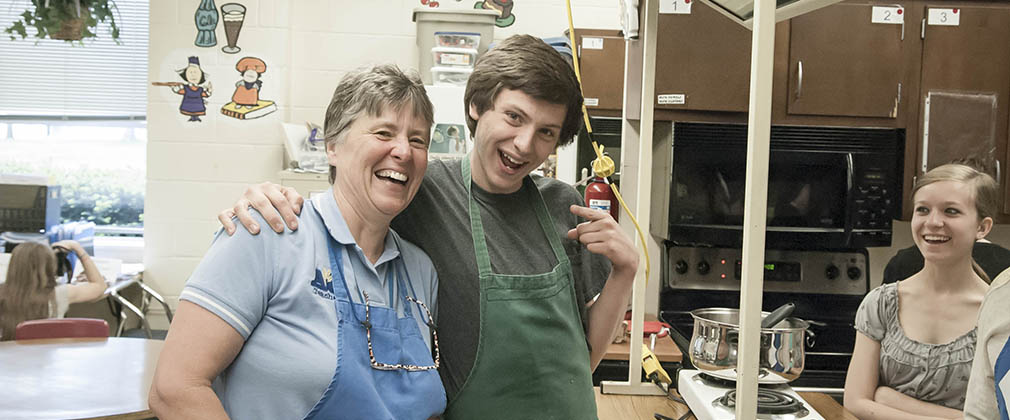Westminster HS students don’t duck responsibility for their food
Various elements of the food system are coming together – in a microcosmic way – on the campus of Westminster High School.
Twenty-three students in an animal care and management class spent two months raising 10 Pekin ducks from tiny chicks to roughly eight-pound adults, and then cooked them and ate them on Thursday. Their teacher, Ruth Chamelin, was one of the beneficiaries of CLF’s Teaching the Food System Grants for Educators program. She used funds from her grant to purchase a hutch to house the ducks and some fencing around their living area, among other things.
The project became a nifty faculty collaboration, as technology teacher Scott Tobias helped Chamelin’s students assemble the hutch, horticulture teacher Emily Hester later donated some of her herbs to season the ducks, and foods teacher Laura Weaner helped supervise the culminating event – five duck dishes assembled and cooked in her kitchen-equipped classroom.
One of the hardest parts of the project was finding a place to process the ducks – a testament to the fact that few small-scale slaughtering facilities remain. Chamelin had to drive an hour and 20 minutes to find a certified processor who would slaughter her flock – “a Mennonite gentleman who did a nice job for us.”

On Thursday, Weaner’s classroom quickly filled with delicious aromas as a duck stir fry, duck over penne pasta, pan-roasted duck with a Cajun rub, duck enchiladas, and duck-enhanced quesadillas (Weaner coined the term “duckadillas”) began to take shape.
In one corner, a couple of boys decided to put aside their butchering knives and use their hands to tear apart their duck carcass. There was general enthusiasm for the necessary kitchen tasks, but a range of interest in eating the final result. Chamelin was careful to tell her students that if anyone didn’t feel good about cooking or eating the ducks, they had the options of being absent from class that day or simply abstaining from direct involvement. No one took her up on either offer.
Sophomore Waverly Brown was fully in the mix as far as preparing and cooking, but she was on the fence about eating the final product.
“I might [try the duck meat], because I know that they were killed humanely and they were raised in a good environment,” she said. “But I tend to not want to eat animals who were raised in a place where they were uncomfortable. I don’t eat red meat at all. I would eat poultry, but it’s hard to find poultry that’s raised well.”
Waverly, who did end up trying the duck, liked the small-scale nature of this whole operation, “the personalness of it – seeing them as animals and not just products.
“It’s the kind of thing that I wish I’d been raised around it more,” she said. “I couldn’t live on a farm, because I get so attached to animals.”
Her classmate, Colby Dull, does live on a farm, and for about 10 years has been showing his cattle, sheep and pigs at local farm events. Also a sophomore, he already has his sights set on studying animal science at Oklahoma State.
“They have a nice cattle program. I’m big into cattle, and seeing the end product being made,” he said. “I’ve always seen agriculture as being a big part of my life.”
As a young farming enthusiast, Colby is an exception, even at a somewhat rural high school like Westminster.
“Most of them just don’t have a clue where their food comes from,” Chamelin said of her students. “I had one girl in my class who said ‘I always thought milk was cow pee.’ And another girl across the room said ‘Oh, my god, I did, too.’ ”
Chamelin, who until 2004 owned a herd of 60 pastured dairy cows with her husband, bemoaned the lack of hands-on agricultural education in schools.
“I think Hereford High was the last one around here to have a farm, but that’s all gone now,” she said. “It’s pretty much all in the classroom, learning from a textbook. And you just can’t learn agriculture that way.
“And it’s been really nice to bring in some sustainable agriculture, because it’s not in our curriculum, I can tell you that.”
Fresh off the success of this project, Chamelin wants to branch out beyond ducks next fall, but isn’t yet sure in what direction. Chickens could be next, or goats that could be milked to make soft cheeses, or the hutch could be a temporary home for a pig or calf. She has overcome her initial fears about how the students would behave around farm animals.
“I was not sure that the kids would leave them alone,” she said. “But, the kids were great. They watched over things. I guess I need to not worry about that.”
To avoid becoming too emotionally attached to the ducks (“some of the girls wanted to get warm and cuddly with them”), Chamelin said she and her students didn’t name their livestock. Instead, “they just kind of called all of them ‘George’ – one name for the whole flock.”
